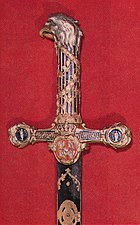Royal Castle, Warsaw
| Royal Castle | |
|---|---|
Zamek Królewski | |
German Army)[1] | |
| Client | Sigismund III Vasa |
| Height | 60 metres |
| Design and construction | |
| Architect(s) | Matteo Castelli, G. B. Trevano, Gaetano Chiaveri |
| Website | |
| www | |
Europe | |
Historic Monument of Poland | |
| Designated | 1994-09-08 |
| Part of | Warsaw – historic city center with the Royal Route and Wilanów |
| Reference no. | M.P. 1994 nr 50 poz. 423[2] |
The Royal Castle in Warsaw (
The Royal Castle witnessed many notable events in Poland's history; the
In 1965, the surviving wall fragments, cellars, the adjacent Copper-Roof Palace and the Kubicki Arcades were registered as historical monuments. Reconstruction was carried out in the years 1971–1984, during which it regained its original 17th-century appearance. In 1980, the Royal Castle and surrounding Old Town became a UNESCO World Heritage Site. It is the second most visited art museum in Poland (after the Wawel Castle in Kraków) and the 25th most visited art museum in the world with over 2.02 million visitors in 2023.[4]
History
Overview
The history of the castle dates back to the 14th century when the first Castle Tower was constructed and the fortified complex was initially used as the residence of the
Castle in the Middle Ages

In 1339 the
In the middle of the 14th century the Castle Tower was built and its remains up to the first storey have survived to this day. During the reign over
Renaissance period

When the
The Curia Maior was altered so as provide a meeting place for the
Vasa period and the Deluge


The next alterations to the Castle were made in the reign of
Between 1601 and 1603 Giacomo Rodondo
On 29 October 1611 in the Senator's Chamber, Tsar Vasili IV of Russia, who had been captured by the hetman Stanisław Żółkiewski, paid homage to the Polish king Sigismund III Vasa.
The Polish king Sigismund III and his successors of the Vasa dynasty —
The majority of the preserved castle furnishings from the Vasa period found their place in the collection of the Visitationist Monastery in Warsaw as donations from the last Vasa, John II Casimir and his French-born wife Marie Louise Gonzaga.[12]
In 1628 the first
Late Baroque period




In 1657 the reconstruction of the castle started, under the Italian architect Izydor Affait's guidance. Because of the lack of money the following Polish king,
After choosing
The reconstruction according to Karcher's plans began from 1713 to 1715.[14] In 1717 the Parliament Hall was completely rebuilt.[14] It was used to serve the Saxon rulers as a coronation hall. During the following years, between 1722 and 1723, the other castle halls were converted-under the direction of architect Joachim Daniel von Jauch, the new Senate Chamber was built, and all the furnishings moved from the old to the new location, including among others: 60 Polish provincial emblems, panelling, mouldings and lesene.[14] On 31 May 1732, a fire broke out in the castle destroying the west elevation and part of the Sigismund's Tower and the exterior façade sculptures, known as armature.
The next reconstruction project of the Royal Castle appeared after
Enlightenment period

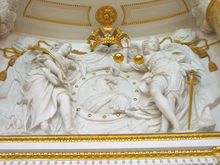
The most splendid period in the history of the Castle was during the rule of

During 1766–1785 on the basis of Jakub Fontana's plans,
Up until 1786
During this period, the Castle was the place where the ideas of the
In partitioned Poland and the Second Polish Republic
Between 19 and 20 December 1806 and 1–30 January 1807,

In 1836, after abolishing the division into voivodeships in the
After the
During the
During World War II
On 17 September 1939, the Castle was shelled by German artillery. The roof and the turrets were destroyed by fire (they were partly restored by the Castle's staff, but later deliberately removed by the Germans).[18] The ceiling of the Ballroom collapsed, resulting in the destruction of Bacciarelli's ceiling fresco The Creation of the World and other rooms were slightly damaged. But immediately after the seizure of Warsaw by the Germans, their occupation troops set to demolish the castle. The more valuable objects, even including the central heating and ventilation installations, were dismantled and taken away to Germany.

On 4 October 1939 in Berlin,
In 1944, after the collapse of the Warsaw Uprising, when hostilities had already ceased, the Germans blew up the Castle's demolished walls.[18] Leveling the Royal Castle was only a part of a larger plan – the Pabst Plan – the goal of which was to build a monumental Community Hall (ger. Volkshalle) or an equally sizable Congress Hall of NSDAP (National Socialist German Workers Party – ger. Parteivolkshalle) in the Royal Castle's place and to replace the Sigismund's Column with the Germania Monument.
A pile of rubble, surmounted by only two fragments of walls, was all that was left of the six-hundred-year-old edifice. On one of these fragments part of the stucco decoration remained, this was a cartouche with the royal version of the motto of the Order of the White Eagle — "PRO FIDE, LEGE ET REGE" (for Faith, Law, and King).
Reconstruction

Immediately after the end of war in 1945, work started on rescuing the surviving fragments of the castle's walls, foundations, and cellars as well as the fire-blackened walls of the
By May 1975 the Fund had already reached the 500 million
Today
-
Royal Castle's eastern baroque façade seen from the Royal Gardens.
-
Panoramic view of the castle and the Old Town.
The imposing façade, built of brick, is 90 metres (300 ft) long and faces the Castle Square.[19] At each end of the façade stands a square tower with a bulbous spire. The Sigismund's Tower is located in the centre of the main façade, flanked on both sides by the castle. This huge clock tower (60 metres (200 ft) in height), designed in the 17th century, has always been a symbol of the Polish capital and source of inspiration for the architects of other buildings in Warsaw. The castle now serves as a museum and is subordinated to the Ministry of Culture and National Heritage. Many official visits and state meetings are also held in the Royal Castle.
Interior

The interior consists of many different rooms, all painstakingly restored with as much original exhibits as possible after the destruction of the Second World War.
- The JagiellonianRooms
These rooms, which belonged to the residence of
- The Houses of Parliament
From the 16th century onwards, Polish
- The Royal Apartments
In these apartments, King Stanisław Augustus Poniatowski lived. They consist of the Canaletto room, in which several painted views of Warsaw are on display.[8] These were not painted by Canaletto, but rather by his nephew, Bernardo Bellotto also called il Canaletto. Jean-Baptiste Pillement worked between 1765 and 1767 on one of his largest projects, the wallpaper.[8] Domenico Merlini designed the adjacent Royal Chapel in 1776.[8] Nowadays, the heart of Tadeusz Kościuszko is kept here in an urn. The Audience Rooms are also designed by Merlini, with four paintings by Marcello Bacciarelli on display. Andrzej Grzybowski took care of the restoration of the room, that included many original pieces.
- Lanckoroński Collection
In 1994
In December 2018, the Castle acquired a violin created by Antonio Stradivari in 1685. To commemorate the 100th anniversary of Poland regaining its independence, the instrument was officially given the name Polonia. The virtuoso violinist Jerzy Wawrowski is the only person who is allowed to play on the instrument.[25]
In December 2018, a painting by Marcello Bacciarelli titled Portrait of Jerzy Mniszech with Daughter Elizabeth and Kiopek (1795), which was considered missing, was returned to the Castle's collections.[26][27]
Gallery
- The Interior of the Castle
-
New Chamber of Deputies
-
OldChamber of Deputies
-
Senatorial Hall
-
The Throne
-
The Throne Room
-
Royal Council Room
-
Old Audience Chamber
-
Conference Room
-
Great Assembly Hall
-
Marble Room
-
Knight's Room
-
Royal Apartment
-
Royal Bedroom
-
Canaletto Room
-
Yellow Room
-
Gothic cellar
-
Kubicki Arcade
- Artwork
-
Portrait of Charles I Stuart, Anthony van Dyck, ca.1638
-
Adam and Eve, Lucas Cranach the Elder, ca. 1528
-
Saint John the Baptist, Joos van Cleve, ca.1540
-
Portrait of George III of the United Kingdom in Parliament Robes, Thomas Gainsborough, 1785
-
Portrait of Pélagie Sapieżyna-Potocka,Louise Élisabeth Vigée Le Brun, 1794
-
Country Doctor, David Teniers the Younger, second half of 17th century
-
Portrait of Pope Pius VI, Pompeo Batoni, ca.1780
-
Marie Antoinette in the Temple Prison, Alexander Kucharsky, 1793
-
Prince Władysław Vasa, Jakob Troschel, 1605
-
Queen Constance of Austria, Jakob Troschel, 1624
-
Art Cabinet of Prince Władysław Vasa, Etienne de la Hire, 1626
-
Ceremonial sword of the Saint Stanislaw's Order, 1764
Copper-Roof Palace

The Copper-Roof Palace has since 1989 been a branch of the Royal Castle Museum.[29] The palace is contiguous with Warsaw's Royal Castle, and down a slope from the Castle Square and Old Town. It was originally a patrician house of Wawrzyniec Reffus, it was built 1651–1656.[30] After 1657 destruction by the army of George II Rákóczi, it was completely remodeled in 1698–1701[10] for Jerzy Dominik Lubomirski.[30]
Lubomirski expanded the palace by building a southern wing, perpendicular to the rest of structure, and also expanded the western elevation. Shortly after its construction the palace became known as Palais Martin, after Lubomirski's grandson.
The Copper-Roof Palace was burned in 1944 and reconstructed, based on paintings of Bernardo Bellotto, between 1948 and 1949.[10]
Currently the palace is a museum hosting, inter alia, a permanent exhibition of
Interesting facts

- On 24 May 1829 in the Royal Castle's Senator's Hall,
- On 5 November 1916, the Act of 5 November was announced in the Grand Hall.[36]
- On 23 April 1935, the April Constitution was signed in the Knight Hall.[19]
- Stanisław Augustus Poniatowski's regalia are kept in the Royal Chapel. These are the Order of the White Eagle, the ceremonial sword of the Saint Stanisław's Order and aquamarine sceptre.[8]
- The insignia of presidential power are also stored in the Castle- the stamp of the President, the Jack of the President of the Republic of Poland and national documents, which Ryszard Kaczorowski gave to Lech Wałęsa on 22 December 1990.[37]
- Many of the Polish legends are connected with the Royal Castle. According to one of them in 1569 the King Sigismund Augustus, who was in mourning after death of his beloved wife Barbara Radziwiłł, asked the renowned sorcerer Master Twardowski to evoke her ghost.[38][39] The experiment was successful with support of a magic mirror, which today is kept in the Węgrów Cathedral.[38] Despite that some people suspected that it was not the Queen's ghost but closely resembling her king's mistress Barbara Giżanka and the whole event was set up by Giżanka's accomplice Mikołaj Mniszech, king's chamberlain.[39]
- The Royal Castle in Warsaw is one of the official members of the Association of European Royal Residences.[40]
- In 2014, the zloty coin in a series called "Discover Poland" depicting the Royal Castle in Warsaw.[41]
Chicago replica
In 1979, the historic
See also
- Castle Square
- St. John's Cathedral
- Sigismund's Column
- Castles in Poland
References
- ^ a b c d e "History of Royal Castle – official website". 16 May 2010.
- ^ Zarządzenie Prezydenta Rzeczypospolitej Polskiej z dnia 8 września 1994 r. w sprawie uznania za pomnik historii., M.P. z 1994 r. Nr 50, poz. 423
- ^ "Sale Sejmowe". zamek-krolewski.pl (in Polish). Retrieved 18 July 2008.
- ^ Cheshire, Lee; da Silva, José; Research by Lillie Ellen Moller and Robert Palk (26 March 2024). "The 100 most popular art museums in the world—blockbusters, bots and bounce-backs". The Art Newspaper. Retrieved 26 March 2024.
- ^ a b Ewa Suchodolska. "Zamek książąt mazowieckich (ok. 1300 – 1526)". zamek-krolewski.pl (in Polish). Retrieved 10 March 2013.
Znaczenie Warszawy potwierdzają wystawiane tam dokumenty, jak również świadectwo wysłanników papieskich. W 1339 r. postrzegają oni tu ważny, a zarazem bezpieczny ośrodek, w którym książę często przebywa ze swym dworem i sprawuje sądy. (...) Na początku XV w. Janusz I rozpoczął w Warszawie budowę okazałego domu książęcego (nazywanego w dokumentach Curia Maior lub Curia ducalis) co tłumaczy się jako Dwór Wielki (książęcy) lub Dom Duży.
- ^ a b c d e f Marek Wrede. "Zamek Jagiellonów i pierwszych królów elekcyjnych (1526–1586)". zamek-krolewski.pl (in Polish). Retrieved 24 March 2013.
(...) w 1526 roku miała miejsce druga, dużo ważniejsza królewska wizyta w Warszawie. Do miasta, w drodze z Gdańska do Krakowa, zjechał z licznym orszakiem Zygmunt I. Objął w posiadanie Zamek i całą mazowiecką dzielnicę jako spadek po bezpotomnie zmarłych piastowskich lennikach (...) Po śmierci króla Zygmunta I w 1548 roku Bona przeniosła się na stałe na Mazowsze. (...) Włoski architekt Giovanni Battista Quadro z Lugano (twórca renesansowego ratusza poznańskiego), współpracujący początkowo z Jacopem Pario z Bisone, przekształcił średniowieczne zabudowania zamkowe (...) Rozbudowano dawną rezydencję książęcą – Dwór Wielki przekształcając ją w gmach sejmowy. (...) Od północy dobudowano posadowiony na wysokiej piwnicy Nowy Dom Królewski z zewnętrzną okrągłą klatką "wschodów kręconych". (...) Lubelski sejm 1569 roku wyznaczył Warszawę i Zamek na stałe miejsce obrad sejmu zjednoczonej Rzeczypospolitej.
- ^ a b c d Peter K. Gessner (15 September 1993). "Warsaw's Glorious Royal Castle". info-poland.buffalo.edu. Archived from the original on 26 November 2012. Retrieved 10 March 2013.
Later, King Zygmunt August held meetings of the Polish parliament there. In 1569, after the Union of Poland and Lithuania, Warsaw, conveniently equidistant from Krakow and Vilno, the two capitals, became the permanent location for such meetings which took place at the Zamek. (...) The King's architect at the start of this period was Jakub Fontana (1710–1773). (...) Above the line of the Royal paintings, against a background of trophies, hang Bacciarelli's portraits of 10 Polish men of note (Copernicus, Hodkiewicz, Cromerus ... ) (...) On 3 May 1791 the Sejm enacted a new constitution in the Senate Chamber (4), the first one to be enacted in Europe and one proclaiming equality.
- ^ a b c d e f g h i "Zamek Królewski w Warszawie (The Royal Castle in Warsaw)". dziedzictwo.pl (in Polish). Retrieved 18 July 2008.
- ^ a b c d e f g h i Marek Wrede. "Zamek Wazów i królów rodaków (1587–1696)". zamek-krolewski.pl (in Polish). Retrieved 22 April 2013.
Król w swej nie ukończonej jeszcze, północnej rezydencji zamieszkał na jesieni w 1611 roku. Od tego czasu Warszawa – centrum parlamentarne oraz siedziba króla i centralnych urzędów. (...) Twórcami jej byli włoscy architekci: Giovanni Trevano, Giacomo Rodondo, Paolo de la Corte oraz Mateo Castello. (...) W skrzydle południowym powstał przed rokiem 1637 zespół sal z głęboką sceną i widownią wyposażonych w instrumentarium pozwalające wystawiać przedstawienia w bogatej barokowej scenografii. (...) Wiosnę 1656 roku administracja szwedzka rozpoczęła planową grabież i dewastację. Wywożono wszystkie cenne rzeczy – obrazy, rzeźby, meble także marmurowe posadzki, kominki i fontanny ogrodowe. Wnętrza zamkowe używane jako lazarety i stajnie zostały kompletnie zdewastowane. Trzy okupacje (tym ostatnia siedmiogrodzka) położyły kres wspaniałości wazowskiej rezydencji.
- ^ a b c d e f "The Royal Castle". eGuide / Treasures of Warsaw on-line. Retrieved 23 July 2008.
- ^ ISBN 99-86669-30-8.
- ^ Agnieszka Fryz-Więcek (2005). Świat ze srebra. Muzeum Narodowe w Krakowie. p. 55.
- ^ a b "Sala operowa". Opera i teatr Władysława IV (in Polish). Archived from the original on 20 August 2011. Retrieved 23 July 2008.
- ^ a b c d e f g h i j k l "Zamek Królewski za Sasów" (in Polish). Retrieved 23 July 2008.
- ^ Marcin Latka. "Altar od king Stanislaus Augustus from the Saxon Chapel at the Royal Castle in Warsaw". Retrieved 16 September 2018.
- ^ a b Agnieszka Kania; Monika Bryzek. "Biblioteka Stanisława Augusta Poniatowskiego (Library of Stanisław August Poniatowski)". wsp.krakow.pl (in Polish). Archived from the original on 24 May 2008. Retrieved 23 July 2008.
{{cite web}}: CS1 maint: multiple names: authors list (link) - ^ "Royal Castle in Warsaw". castles.info. Archived from the original on 13 January 2010. Retrieved 18 July 2008.
- ^ a b c d Peter K. Gessner. "Warsaw's Royal Castle and its destruction during the Second World War". info-poland.buffalo.edu. Archived from the original on 10 May 2008. Retrieved 23 July 2008.
- ^ a b "Warszawa Zamek Królewski". zamkipolskie.com (in Polish). Retrieved 22 July 2008.
- ^ "Pokoje Dworskie". zamek-krolewski.pl (in Polish). Retrieved 18 July 2008.
- ^ "Galeria Malarstwa, Rzeźby i Sztuki Zdobniczej". zamek-krolewski.pl (in Polish). Retrieved 2 March 2013.
- ^ a b "Dawna Izba Poselska i sale sąsiednie". zamek-krolewski.pl (in Polish). Retrieved 18 July 2008.
- ^ "Galeria Lanckorońskich". zamek-krolewski.pl (in Polish). Retrieved 18 July 2008.
- ^ "Historia dwóch obrazów". zamek-krolewski.pl (in Polish). Retrieved 18 July 2008.
- ^ "Stradivarius "Polonia" on display in the Royal Castle in Warsaw". Retrieved 16 February 2019.
- ^ "Kept in a vault under armed guard, TFN gets exclusive glimpse at 'hugely important' painting hidden from public view for 200 years". Retrieved 21 September 2019.
- ^ "Nowe nabytki Zamku – portret Marcella Bacciarellego i kolekcja biskwitów". Retrieved 16 February 2019.
- ^ Stuart Dowell (8 January 2024). "First Raphael in Polish collection since theft of 'Portrait of a Young Man' arrives in Warsaw". thefirstnews.com. Retrieved 14 January 2024.
- ^ "Remont i przebudowa pałacu Pod Blachą". zamek-krolewski.pl (in Polish). Archived from the original on 29 September 2010. Retrieved 23 March 2009.
- ^ a b c "Pałac pod Blachą". warszawa1939.pl (in Polish). Retrieved 23 March 2009.
- ^ a b c d ""Under the Metal Roof" Palace (Palac Pod Blacha)". wiezowce.waw.pl. Archived from the original on 4 February 2014. Retrieved 24 March 2009.
- ^ "Wystawa kobierców wschodnich". zamek-krolewski.pl (in Polish). Retrieved 23 March 2009.
- ^ "Fundacja Teresy Sahakian". zamek-krolewski.pl (in Polish). Retrieved 23 March 2009.
- ^ "Historia Repliki Polskich Insygniów Koronacyjnych". replikiregaliowpl.com (in Polish). Archived from the original on 23 April 2009. Retrieved 22 July 2008.
- ^ "Insygnia koronacyjne Królów Polski (1025–2003)". polskiedzieje.pl (in Polish). Retrieved 22 July 2008.
- ^ "Akt 5 listopada 1916 roku". dziedzictwo.polska.pl (in Polish). Archived from the original on 30 April 2008. Retrieved 22 July 2008.
- ^ "Wydarzenie". prezydent.pl (in Polish). 2 November 2004. Archived from the original on 28 February 2005. Retrieved 22 July 2008.
- ^ a b Jan Mielniczka (29 October 2007). "Legendy o Węgrowie". wegrow.com.pl (in Polish). Archived from the original on 6 October 2008. Retrieved 19 March 2009.
- ^ a b Franciszek Kucharczak (7 August 2007). "Duchotwórca". maly.goscniedzielny.pl (in Polish). Retrieved 11 February 2010.
- ^ "Full members". Retrieved 9 May 2019.
- ^ "Banknoty i monety". Retrieved 9 May 2019.
- ^ Northwest Chicago Historical Society. Newsletter – January 2005; Number 1 www.nwchicagohistory.org Archived 27 July 2011 at the Wayback Machine
Bibliography
- Lileyko Jerzy (1980). Vademecum Zamku Warszawskiego (in Polish). Warsaw. ISBN 83-223-1818-9.)
{{cite book}}: CS1 maint: location missing publisher (link - ISBN 83-01-03323-1.)
{{cite book}}: CS1 maint: location missing publisher (link
External links
- Royal Castle website
- The Royal Castle in Warsaw – Museum at Google Cultural Institute
- Zamek Królewski w Warszawie – Muzeum – Google Art Project
- Virtual tour
- Castles.info—Royal Castle in Warsaw Archived 13 January 2010 at the Wayback Machine — history and pictures.
- Google's Virtual Walk of the Royal Castle




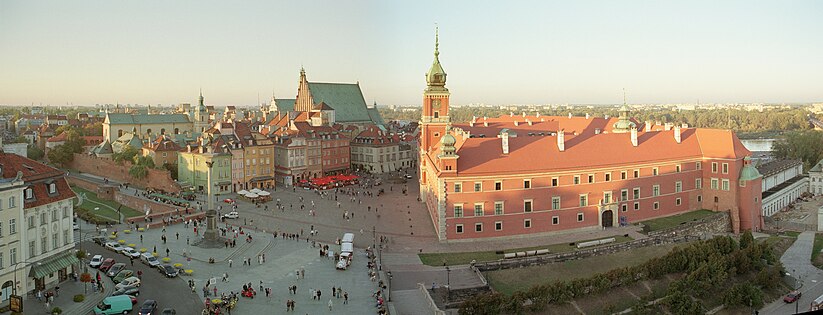


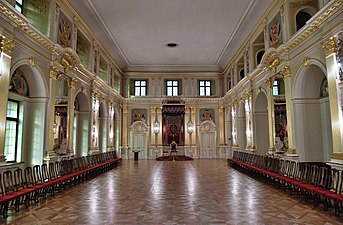





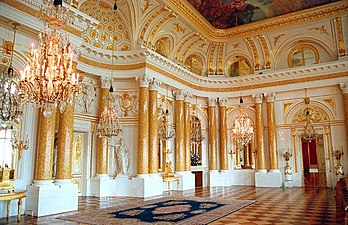
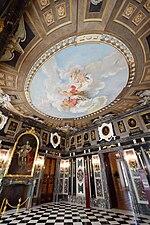








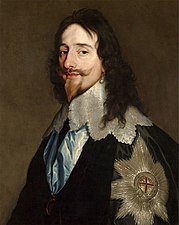

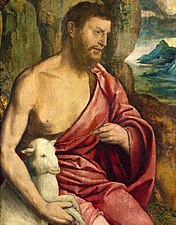





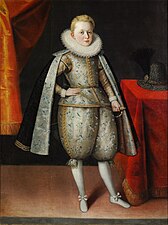


![A Standing Soldier in Armor Seen in Profile by Raphael, c. 1500[28]](http://upload.wikimedia.org/wikipedia/commons/thumb/0/05/A_Standing_Soldier_in_Armor_Seen_in_Profile_by_Raphael.jpg/146px-A_Standing_Soldier_in_Armor_Seen_in_Profile_by_Raphael.jpg)
